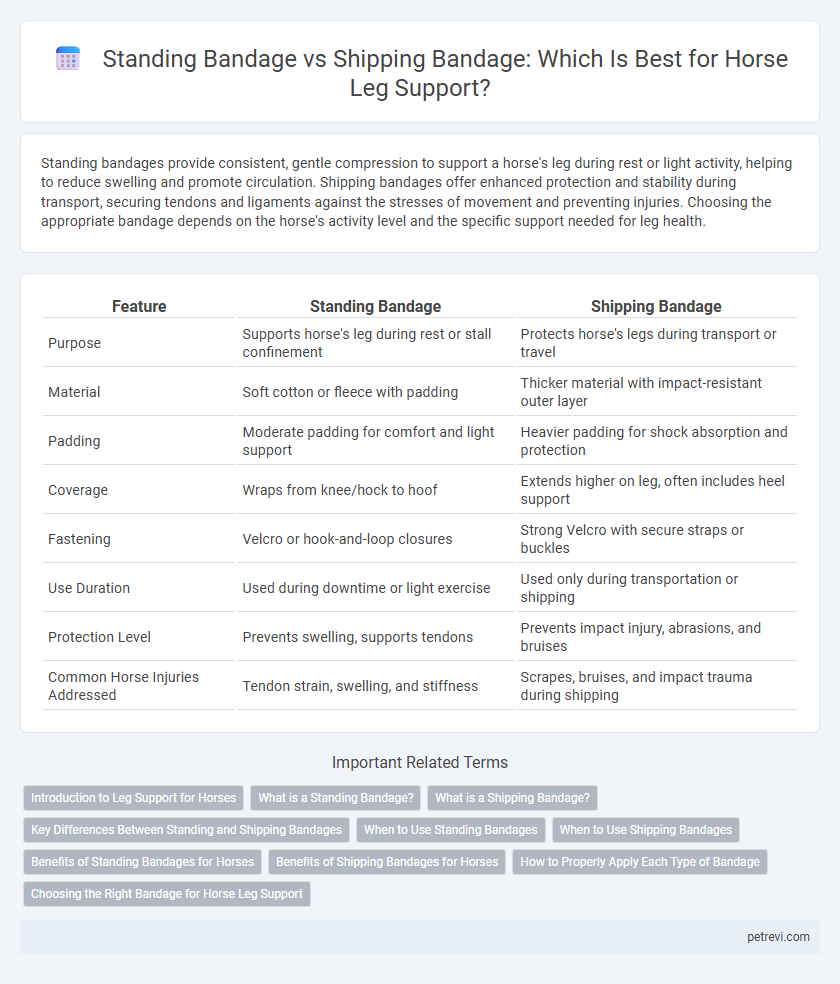Standing bandages provide consistent, gentle compression to support a horse's leg during rest or light activity, helping to reduce swelling and promote circulation. Shipping bandages offer enhanced protection and stability during transport, securing tendons and ligaments against the stresses of movement and preventing injuries. Choosing the appropriate bandage depends on the horse's activity level and the specific support needed for leg health.
Table of Comparison
| Feature | Standing Bandage | Shipping Bandage |
|---|---|---|
| Purpose | Supports horse's leg during rest or stall confinement | Protects horse's legs during transport or travel |
| Material | Soft cotton or fleece with padding | Thicker material with impact-resistant outer layer |
| Padding | Moderate padding for comfort and light support | Heavier padding for shock absorption and protection |
| Coverage | Wraps from knee/hock to hoof | Extends higher on leg, often includes heel support |
| Fastening | Velcro or hook-and-loop closures | Strong Velcro with secure straps or buckles |
| Use Duration | Used during downtime or light exercise | Used only during transportation or shipping |
| Protection Level | Prevents swelling, supports tendons | Prevents impact injury, abrasions, and bruises |
| Common Horse Injuries Addressed | Tendon strain, swelling, and stiffness | Scrapes, bruises, and impact trauma during shipping |
Introduction to Leg Support for Horses
Standing bandages provide consistent compression and protection to a horse's lower legs during rest or light activity, reducing swelling and preventing injury. Shipping bandages offer enhanced support and cushioning designed specifically for transportation, securing tendons and ligaments against strain in confined spaces. Proper application of either bandage type is crucial for maintaining leg health and preventing damage during different activities.
What is a Standing Bandage?
A standing bandage is a type of leg wrap designed to provide support and protection to a horse's lower leg during rest or light activity. It helps prevent swelling and offers moderate cushioning against minor bumps or abrasions. Unlike shipping bandages, standing bandages are not intended for travel and are typically used in stables or during recovery periods.
What is a Shipping Bandage?
A shipping bandage is a specialized wrap designed to protect a horse's legs during transportation, offering support and cushioning to minimize the risk of injuries. It typically covers the cannon bone, fetlock, and hoof, securing the lower leg with multiple layers of padding and a stable outer wrap. Unlike standing bandages, shipping bandages provide more robust protection against bumps and knocks experienced during travel.
Key Differences Between Standing and Shipping Bandages
Standing bandages provide moderate support and protection for a horse's legs during rest or stable confinement, designed to reduce swelling and protect minor injuries. Shipping bandages offer increased cushioning and secure padding, specifically constructed to protect the horse's legs from impact and injuries during transportation. The key differences lie in their thickness, coverage, and closure systems, with shipping bandages typically being thicker and more robust to withstand the rigors of travel.
When to Use Standing Bandages
Standing bandages provide crucial support and protection to a horse's legs during rest, recovery, or stable confinement, effectively reducing swelling and preventing injuries from minor knocks. These bandages are ideal for use after strenuous exercise or medical treatments, promoting circulation and aiding the healing process. Unlike shipping bandages designed for transportation, standing bandages offer stable compression without the heavy padding necessary for travel shock absorption.
When to Use Shipping Bandages
Shipping bandages are specifically designed to protect a horse's legs during transportation by providing cushioning and preventing injuries caused by bumps or shifts in movement. They are essential for long-distance travel or trips on rough terrain where the risk of knocks and abrasions increases. Unlike standing bandages, shipping bandages include additional padding and secure fastenings to ensure maximum support and protection throughout the journey.
Benefits of Standing Bandages for Horses
Standing bandages provide essential support to a horse's tendons and ligaments during rest or light activity, promoting proper circulation and reducing swelling. These bandages offer protection against minor cuts and abrasions while maintaining comfort for extended periods. Their secure fit helps prevent injuries during daily stable routines without restricting the horse's movement significantly.
Benefits of Shipping Bandages for Horses
Shipping bandages provide superior protection and support for horse legs during transportation by minimizing swelling and preventing injuries from sudden movements or impact. Made with durable, breathable materials, they offer stability while allowing airflow to reduce heat buildup and promote comfort. Their comprehensive coverage safeguards tendons and ligaments, enhancing overall leg health in transit compared to standing bandages.
How to Properly Apply Each Type of Bandage
Standing bandages are applied with moderate tension to support a horse's leg and protect it during turnout or exercise, starting from just above the fetlock and wrapping evenly upward toward the knee or hock while avoiding excessive pressure points. Shipping bandages require a more secure and bulkier wrap to safeguard against travel impact, beginning below the knee or hock, covering the entire cannon bone, fetlock, and hoof, then extending upward with firm, overlapping layers to prevent slippage. Proper application of both types involves smooth, consistent pressure, ensuring no gaps or wrinkles, and finishing with secure fastenings such as hook-and-loop straps or tape to maintain leg circulation and prevent discomfort.
Choosing the Right Bandage for Horse Leg Support
Standing bandages provide crucial support and protection during stable rest or light activity, reducing swelling and promoting circulation in a horse's legs. Shipping bandages are designed for transportation, offering more robust cushioning and shock absorption to safeguard tendons and ligaments against travel-related injuries. Selecting the right bandage depends on the horse's activity level, intended use, and the specific type of leg support required to prevent injury and enhance recovery.
Standing Bandage vs Shipping Bandage for Horse Leg Support Infographic

 petrevi.com
petrevi.com